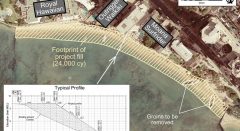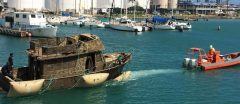Waikiki Beach Maintenance
Sea Engineering was contracted for planning, design, and permitting of a beach maintenance project for the 1,700-foot long shoreline between the Royal Hawaiian groin and Kuhio Beach Park. The objectives of the project were to (1) widen the beach to improve the shoreline and water recreation opportunities, and (2) remove sand from the nearshore sea bottom to create more hard rock substrate for colonization by benthic marine organisms.
The designed nourishment required approximately 24,000 cubic yards of sand to widen the beach by an average of 37 feet. Offshore geophysical investigations identified two sand deposits near the project site containing up to 68,000 cubic yards of sand. Samples from the offshore deposits were shown to be compatible with the existing beach sand.
Historical shoreline analyses have shown this shoreline to be eroding at an average of 1.5 feet per year since 1985. The project included provisions for a renourishment project after about 10 years, requiring approximately 12,000 cubic yards of sand. Including this renourishment, the project would have an effective lifetime of more than 20 years.
SEI’s work also included preparation and coordination of an environmental assessment, and Federal and State permit applications. Environmental coordination included Fish and Wildlife Coordination Act requirements; Endangered Species Act, Section 7 consultation; Clean Water Act, Section 404 evaluation; National Historic Preservation Act coordination; Clean Water Act, Section 401 Water Quality Certification; and Coastal Zone Management Consistency Certification.
The project received the 2012 ASCE Hawaii Best Special Project Award.















